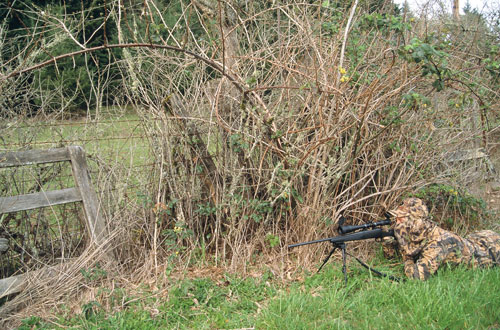Being a consistenly successful hunter involves knowing the animals we're pursuing, their breeding seasons, what they prefer to eat and when they're most active.
But being successful also involves woodsmanship. Walking into the woods with a firearm or bow for predators or big game doesn't translate into meat on the table or fur on the rack. Some hunters have an innate sense about their surroundings and can quickly pick up on the things that help them kill more game. Others, not so much. That's when time, experience, success and failure all come into play to help them gain more understanding of how to be a better hunter.
Here are some proven tips to help you think about habitat, food sources and travel routes to put more fur on the ground.
Always Evolve
Fence lines are a unique habitat continually undergoing change. In this case, change is good. Typically, the older fencerows become, the more of a predator hotbed they evolve into. Take the classic farm fence for example, be it barbed or woven wire. Such fences keep livestock contained within certain areas. The older a fence line grows, the more the microenvironment associated with it changes. Depending on the level of human activity around the fence, be it burning, herbicide use, planting or digging, the progression of the habitat associated with that fence can be dramatically impacted.
One of my favorite fence lines for bobcats and coyotes has been in existence for more than 40 years. A little more than 10 years ago it was a sheep pasture. The wooly critters kept the grass eaten tight to the fence. The farmer also sprayed it to keep the briars down.
When the sheep were pulled from the meadow it turned into a hay field, which means the spraying stopped. Now the long grass growing next to the fence is thick, and the briars are high enough to engulf a house. Today it teams with predator activity. Mind you, the habitat is not yet thick enough for predators to take up residence there, but they do visit it on a regular basis in search of food. I've taken coyote, fox, bobcat and raccoon from it, and have seen two cougars working it over the past three years.
Primary Habitats
In a primary fence habitat, all of the elements are in place that a predator needs to survive: Water, food, protective cover and a place to den. Some of these tangled messes can be incredibly thick, and the thicker the better for predators looking to establish a home.
An old habitat allows food to grow, food that attracts insects, songbirds, upland birds, rodents, squirrels, rabbits and more. As the food chain grows, predators enter the picture and become linked to the area.
Some fence lines grow so thick, however, it's tough setting up directly on them. This is where a ground blind or treestand comes in handy. If a hillside is nearby, the hunter can often set up on the elevated vantage point, with a remote call placed below, and be in a good position to observe all that's going on.
If targeting a thick stretch of fence line featuring broken or open habitat leading up to it, hunters can often position themselves tight to the fence, on the thin fringe, and begin calling. In this situation, the target area is the periphery of the brushy zone.
Such an area can house predators, or can serve as a strong draw to predators as they emerge from daytime hideouts amid dense creek or river bottoms, even adjacent timbered hillsides. Setting up tight to such a semi-brushy location can be very effective.
Travel Routes
Younger fence lines are a bit different when compared to ones encapsulated in brush. Such fence lines don't offer thick enough habitats to entice predators to take up residence, but they do offer forms of food that attract visiting predators on a regular basis. These fairly open habitat zones are where long-distance shooting skills can be put to the test, for concealment is a valid concern, especially in flat terrain.
Again, ground blinds can be effective here, especially one with a low profile. If timber borders the area, treestands may be the best option. Situate a remote calling system at the base of the fence, operate it from the distant treestand or ground blind, and the worries of getting too close to the target area is alleviated.
In addition to offering small food sources that attract predators, young fence lines can be used as primary and secondary travel routes. Primary travel routes are those predators travel along intentionally, on a regular basis, and are most easily identified by distinct trails paralleling the fence line. Predators choose to routinely travel along these routes due to consistently available food sources, and because of the cover offered. It doesn't take much cover to hide a moving predator, and often a foot of tall grass will set their minds at ease.
If there's a lack of large food in the region, predators may be content patrolling such fence lines for rodents, birds and other bite-size prey for extended periods. Predators also travel along these fences because they offer just enough cover to safely reach major hunting grounds situated elsewhere.
Fence lines that serve as secondary travel routes are most easily identified by their lack of cover. Here, predators are using the fence for nothing more than a direct line of travel that happens to link one key habitat to another. Such fence lines have no vegetation growing along them, thus attract little if any food.
 Capitalize on the Moment
Capitalize on the Moment
The closer attention hunters pay to fence lines, the clearer the value of microhabitats become. By taking the time to study the habitat and learn how it's being utilized by predators, the greater the likelihood a person has of increasing hunting opportunities.
One of my favorite times to hunt fence lines that transition into thick creek bottoms amongst farmland is immediately following a heavy rainfall, where creeks flood over their banks. Under such wet conditions, rodents are forced to higher ground.
This past winter I worked one such flooded area, expecting to find a coyote along the edge of the hardwood forest above the creek. Instead, I found a lone dog mousing his way along an overgrown fence situated on higher ground. After failing to connect on the yapper, I examined the area he worked. What I discovered was a labyrinth of deep, miniature trails, obvious sign that meadow voles had been forced to higher ground by the nearby flooding creek.
Fresh snowfall provides another prime time to closely evaluate fence lines. Not only can you find what predator food sources are living in the area, but what travel routes the predators themselves are using. At this point, take time to study the area and figure out why animals are traveling those pathways.
Other factors that influence fence line usage includes human activity, be it hunting for upland birds or deer, which tends to force those species into the confines of thick fencerows in search of refuge. At the same time, as various upland bird species gather in their larger winter flocks, or vertically migrate to lower elevation habitats, which often include fencerows, this can draw predators in on a seasonal basis. If predators aren't there year-round, it's likely due to the fact little food exists.
If this is a habitat that's gone overlooked, take the time to assess what's in the area. Chances are, there could be some fantastic hunting opportunities right at your fingertips.






